Introduction
Are Baby Pigeons Real: The cooing of pigeons and their ubiquitous presence in cities often prompts a curious question: Are baby pigeons real, or do they exist solely in the realm of urban myths? Pigeons, with their gray plumage and distinctive waddle, are a familiar sight to urban dwellers worldwide, but spotting their offspring seems remarkably rare. This enigmatic aspect of pigeon life has given rise to various theories and misconceptions.
The truth is that baby pigeons, often called squabs, do indeed exist, but their elusiveness and unique nesting habits explain why they are seldom seen by the casual observer. Unlike some other bird species, pigeons are exceptionally discreet when it comes to rearing their young.
We will uncover the mysteries surrounding baby pigeons, from their physical characteristics to their nesting habits. We will debunk common myths and reveal the fascinating truths about the hidden lives of squabs. So, join us on this journey as we answer the question: Are baby pigeons real?
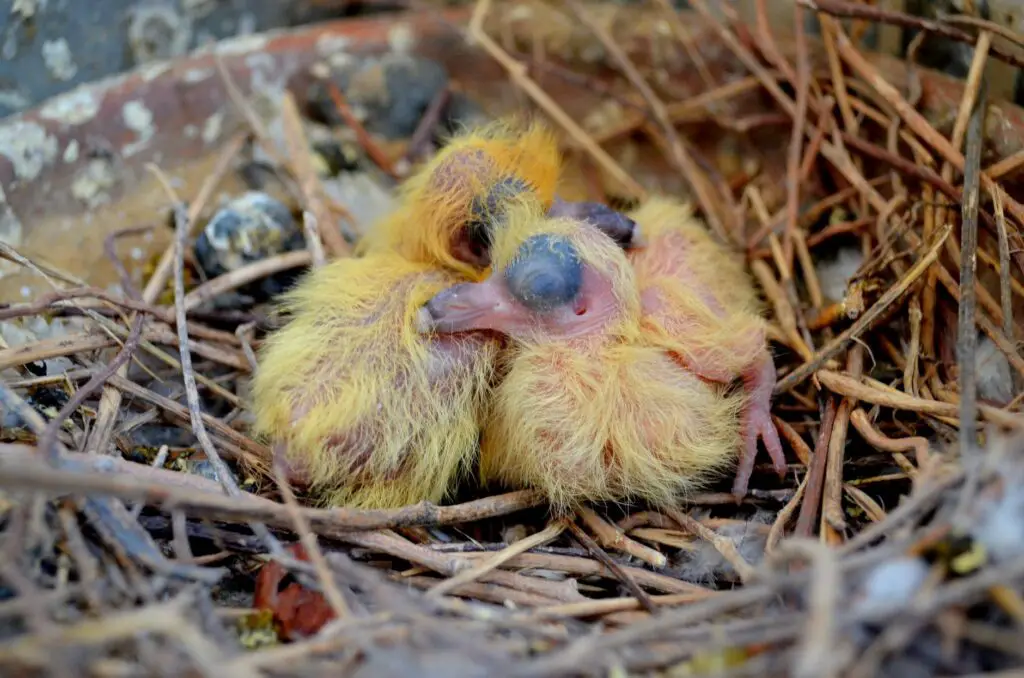
Why do we not see baby pigeons?
Baby pigeons spend a relatively long time in the nest, as much as four to five weeks. When they’re finally ready to fledge, they look just like adult pigeons. That’s why it’s rare to see a baby pigeon in the wild—by the time they leave the nest, they’re indistinguishable from their parents.
The elusive nature of baby pigeons, often referred to as squabs, stems from several factors. Firstly, pigeons are highly protective parents, and they build their nests in concealed, sheltered locations to keep their offspring safe from predators and the elements. These nests are often tucked away on building ledges, tree branches, or other inaccessible spots, making it challenging for humans to spot them.
Secondly, squabs spend a considerable amount of time inside their nests during their early development. When they are first hatched, they are featherless and resemble small, pink, and rather unremarkable creatures. Their lack of feathers and vulnerability during this stage means they remain hidden from view until they grow and develop.
As squabs mature, they gradually grow feathers and start venturing out of the nest but may remain close by, making them less noticeable to observers. By the time they resemble adult pigeons, they often blend seamlessly into the pigeon population, making it challenging to distinguish them as squabs.
So, while baby pigeons do exist and thrive in their concealed nests, their hidden and protected upbringing, coupled with their gradual development, explains why we rarely see them in urban environments.
Can baby pigeons live?
But often the young will survive.” Baby pigeons survive on a diet of pigeon milk—digested epithelial (or skin) cells made in their parents’ crops—until they’re old enough to eat some solid food. “The parents regurgitate charming things like corn kernels and so on,” Walcott says.
Yes, baby pigeons, or squabs, can indeed live and thrive under the care of their parents. Pigeon parents are highly devoted to their offspring and provide them with warmth, nourishment, and protection during their early days.
When squabs are born, they are entirely dependent on their parents for sustenance. Pigeon parents produce a special secretion known as “pigeon milk” in their crops, which is regurgitated and fed to the squabs. This highly nutritious substance provides essential nutrients for the young birds’ growth.
As the squabs mature, their diet gradually transitions to solid food, which they receive from their parents. Pigeon parents continue to care for their squabs by keeping them warm and safe in the nest and teaching them essential life skills, such as preening and flying, as they grow.
In the wild, many squabs successfully fledge and become independent pigeons. However, their survival is subject to various factors, including food availability, environmental conditions, and protection from predators.
Can we touch baby pigeon?
It is never safe for them. If you don’t want to harm the birds, you must wait until the young (squabs) are fledged and have left the nest. Pigeons need 17–19 days to incubate their eggs until they hatch, then about 4 weeks before the squabs leave the nest.
It’s generally best to avoid touching baby pigeons unless it is necessary for their well-being or you are a trained wildlife rehabilitator. Here are a few reasons why:
Health and Safety: Baby pigeons are delicate and susceptible to injury. Handling them without proper knowledge or experience can harm them.
Human Scent: Touching a baby pigeon can transfer your scent onto them, which might make their parents reject them. Pigeons have a keen sense of smell, and they may not recognize their chick if it smells like a human.
Legal Regulations: In many places, it is illegal to disturb or handle wild birds, including pigeons, without the appropriate permits.
If you encounter a baby pigeon that appears to be in distress or abandoned, the best course of action is to contact a local wildlife rehabilitator or animal rescue organization. They have the expertise and legal authority to care for and rehabilitate wild birds.
What do pigeons look like as babies?
A baby pigeon has dark or pink skin and is almost bald, except for some patchy yellow fuzz that will eventually grow into feathers. The long, flat beak is pink, it has fleshy nose wattles, no feathers under its wings, and the feet are grey, and relatively large in proportion to the body.
Baby pigeons, or squabs, have a distinct appearance that sets them apart from adult pigeons. When they are first hatched, squabs are featherless and exhibit a pinkish hue due to the visible blood vessels beneath their skin. They have a plump, cylindrical body shape and relatively large heads in proportion to their bodies.
Over time, as squabs grow and develop, they begin to sprout feathers. Initially, these feathers are sparse and may appear as small, pin-like structures. As they continue to mature, their feathers become more pronounced and develop a soft, downy texture.
Baby pigeons often have closed or partially closed eyes during the early days, and their eyes gradually open as they age. Their beaks are soft and not as rigid as those of adult pigeons, making them well-suited for receiving the regurgitated pigeon milk from their parents.
As squabs transition into adolescence, they start to resemble adult pigeons more closely, with their feathers filling out and their bodies taking on a more typical pigeon shape. Their once-pink skin becomes covered in feathers of various colors and patterns, depending on the pigeon’s specific species.
Are pigeons born or hatched?
Pigeons will start their life in an egg. The mother pigeon will sit on these eggs incubating them for around 18 days.
Pigeons, like all birds, are hatched rather than born. Bird reproduction involves a unique process where eggs are laid by the female, and the development of the embryo takes place inside these eggs. Pigeons follow this same reproductive pattern.
When a female pigeon is ready to reproduce, she will lay one or two eggs in her concealed nest. She then incubates these eggs by sitting on them to keep them warm. The warmth from her body helps to facilitate the development of the embryos inside the eggs.
After a period of incubation, which varies depending on the pigeon species but is typically around 17 to 19 days for common pigeons, the eggs hatch, and baby pigeons, known as squabs, emerge. These squabs are born featherless, blind, and entirely dependent on their parents for food and protection.
So, in the world of pigeons, as in the avian world at large, individuals hatch from eggs rather than being born in the mammalian sense. This fascinating process is a fundamental aspect of bird reproduction and contributes to the diversity of bird species found around the world.
What do baby pigeons eat?
crop milk
The newly hatched squabs are fed on pure crop milk for the first week or so of their lives. Then the parent birds begin to add a proportion of adult food to the mix until by the end of the second week the babies are being fed entirely on regurgitated adult food that has been softened by extra time in the crop.
Baby pigeons, also known as squabs, have a specific diet that evolves as they grow. Initially, when they are newly hatched, squabs primarily ingest a substance known as “pigeon milk.” Both parent pigeons produce pigeon milk in their crops and regurgitate it to feed the squabs. It is a highly nutritious secretion rich in proteins, fats, and essential nutrients necessary for the rapid growth of the young birds.
As squabs continue to develop and their bodies mature, they gradually transition to a diet of solid food. Their diet diversifies to include grains, seeds, and partially digested food that their parents bring to the nest. The adult pigeons play a vital role in teaching their squabs how to feed themselves and gradually introduce them to these solid food items.
Ultimately, squabs’ diets become similar to that of adult pigeons, which includes grains like wheat, barley, and millet, as well as seeds, vegetables, and small insects or invertebrates when available. The transition to solid food is an essential part of their growth and development into independent pigeons.
Can baby pigeons eat rice?
Pigeons will eat almost anything, including rice.
Baby pigeons, also known as squabs, have specific dietary needs during their early stages of life. While adult pigeons are known for their adaptability to a wide range of foods, including grains like rice, the diet of baby pigeons is quite different. Pigeon parents initially feed their squabs with a highly nutritious secretion produced in their crop called “pigeon milk. “Pigeon milk is rich in proteins, fats, and other nutrients essential for the rapid growth and development of squabs.
Rice, especially uncooked rice, is not an appropriate food for baby pigeons. It lacks the necessary nutrients to support their growth and can be challenging for their undeveloped digestive systems to process. Feeding baby pigeons a diet lacking essential nutrients can lead to stunted growth, malnutrition, or even death.
To ensure the health and well-being of baby pigeons, it is crucial to provide them with a suitable diet. If you come across a baby pigeon in need of care, it is advisable to consult with a wildlife rehabilitator or an experienced avian expert to determine the appropriate diet and care regimen.
Do pigeons mourn their babies?
It’s interesting to note that birds exhibit many of the grieving behaviors we do: their posture droops, they appear listless, and often cry real tears. Certain birds—jay birds, pigeons, and ospreys—will remain near where their baby died for long periods of time.
Pigeons, like many other animals, exhibit behaviors that suggest they may experience a form of grief or distress when they lose their offspring. While it’s challenging to definitively attribute human emotions to animals, there is evidence to support the idea that pigeons, as social and intelligent birds, may mourn their babies to some extent.
When pigeon parents lose their chicks due to predation, accidents, or other reasons, they often display signs of distress and agitation. They may vocalize more, spend more time near the nest site, and exhibit restlessness. In some cases, they may attempt to incubate or protect the deceased chick. These behaviors suggest that pigeons are aware of the loss and that it may emotionally affect them.
However, it’s essential to remember that animal behavior can vary, and the extent of mourning or grief can differ between individual pigeons. Animal emotions are not identical to human emotions, so interpreting their behavior requires caution. Pigeons likely experience a combination of instinctual responses and emotions unique to their species.
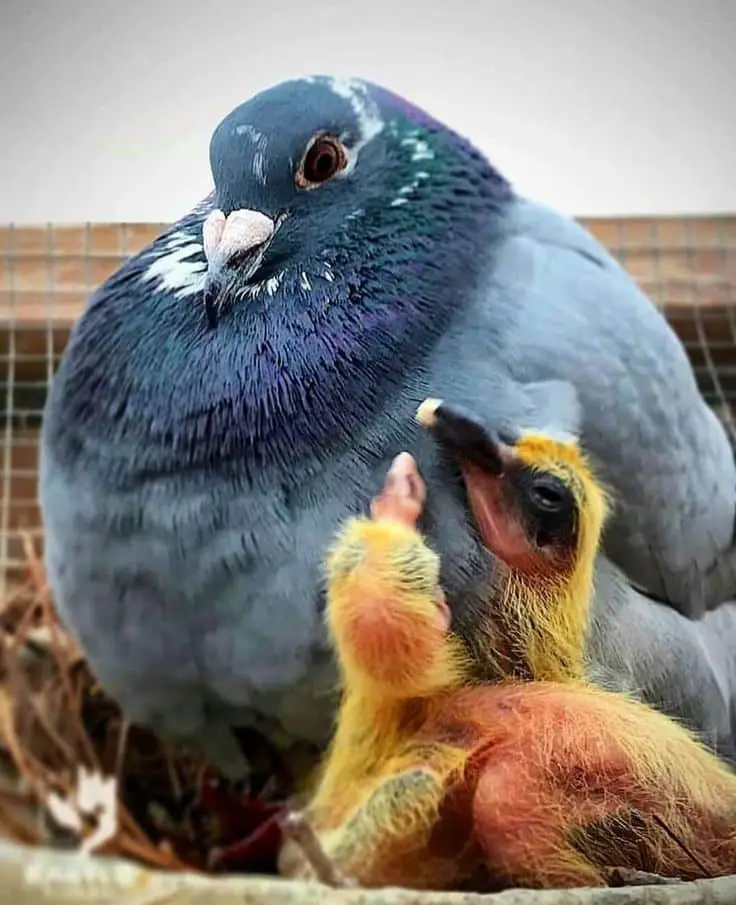
Conclusion
The world of pigeons, often underestimated and misunderstood, holds its share of mysteries, and the existence of baby pigeons, often called squabs, is one such enigma. Through our journey into their hidden world, we’ve unraveled the truth behind these elusive avian youngsters.
Squabs are, indeed, real, and they play a critical role in the life cycle of pigeons. Born in well-concealed nests, squabs are initially featherless and rely entirely on their parents for nourishment and protection. As they grow, they develop feathers, and their appearance gradually shifts from vulnerable hatchlings to fully-fledged pigeons.
The reason behind the scarcity of baby pigeons in urban sightings is primarily due to their discreet nesting habits. Pigeons construct their nests in hidden or sheltered locations, such as building ledges or tree branches, which are often inaccessible to human observers. Moreover, squabs spend a significant portion of their early lives in these concealed nests, further limiting their visibility.
We unveil the truth behind the myth, shedding light on the remarkable yet inconspicuous lives of these avian offspring. They may remain hidden from our gaze, but their existence is a vital part of the complex and fascinating world of pigeons—a world that continues to intrigue and captivate us with its secrets.

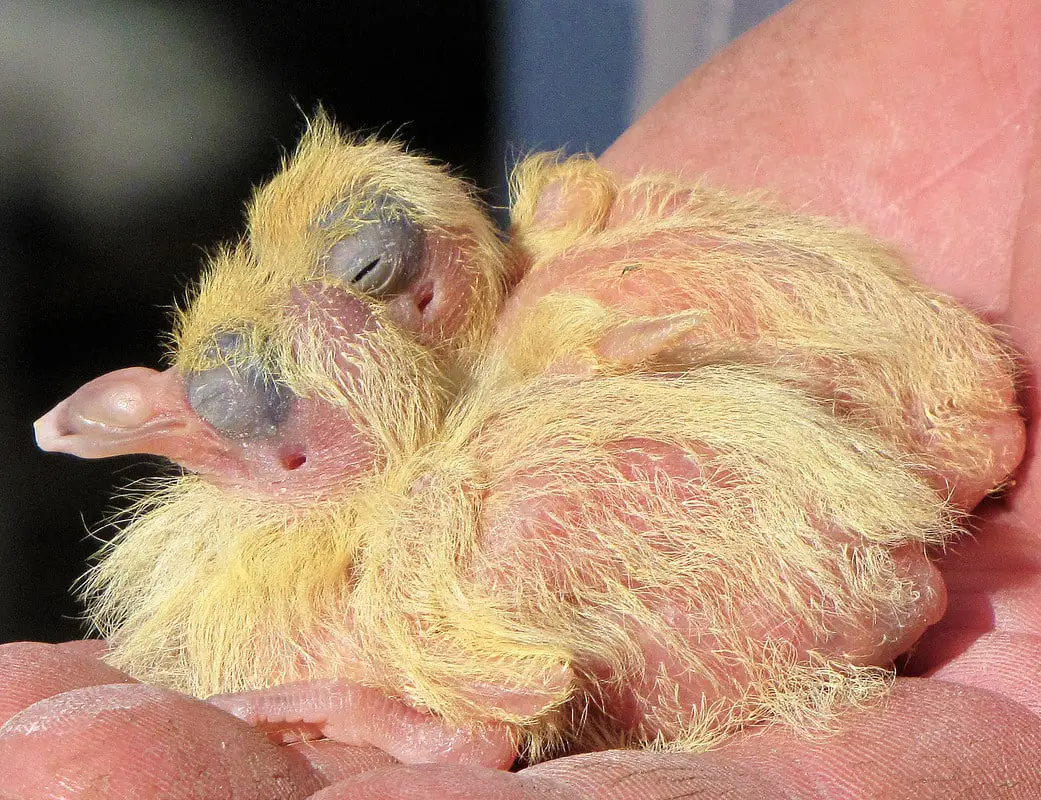
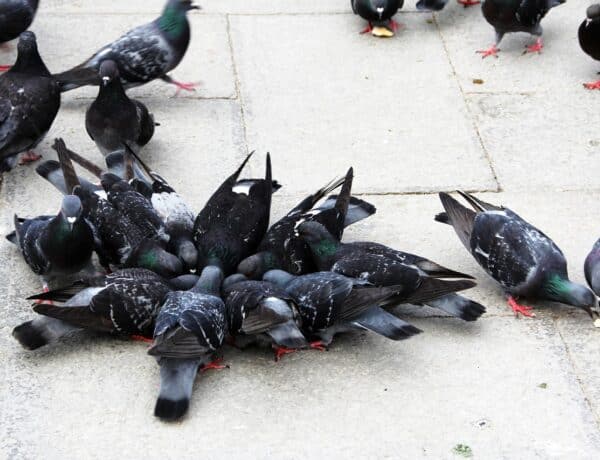
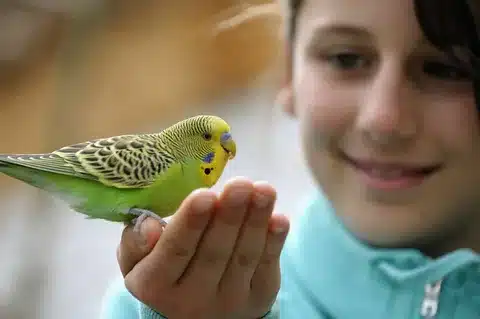
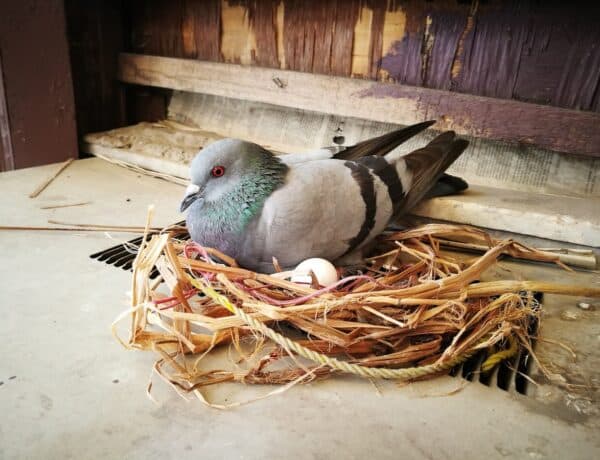
No Comments